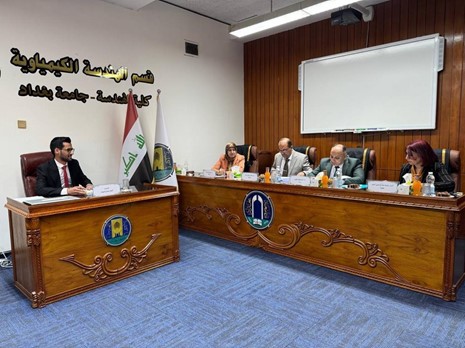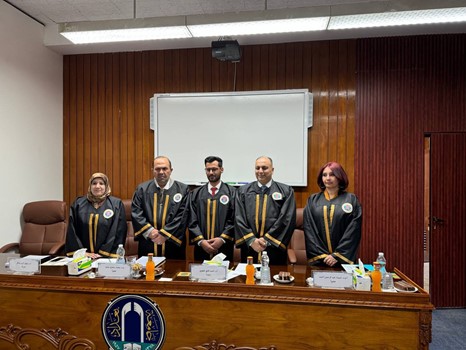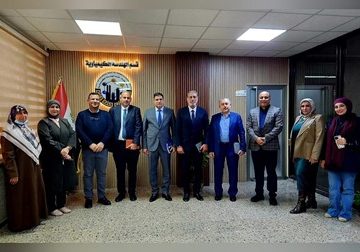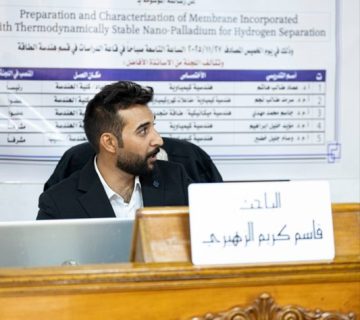The Chemical Engineering Department at the College of Engineering, University of Baghdad, held a M.Sc. thesis examination titled:
“Mass Transfer Performance for CO2 Chemical
Absorption Using Amine Solutions”
By the student Amjad Wadhah Dhuyool and supervised by Prof. Dr. Ibtehal Kareem Shakir. The examination committee consisted of Prof. Dr. Ahmed Faiq Al-Alway as Chairman and the membership of Asst. Prof. Dr. Shaymaa A. Ahmed, and Dr. Mohammed S. Hameed. After conducting the public discussion and listening to the student’s defense, the thesis was accepted. The thesis was summarized as follows:
The interest in lowering greenhouse gas emissions, especially carbon dioxide, has increased awareness of climate change and global warming.
In the present study, two independent stages of the chemical absorption experiments were carried out in a lab-scale absorption column packed randomly with Rashing rings with 1.8 m effective packing height, and 0.04 m inside diameter. The investigation was carried out for simulated flue gas of carbon dioxide balanced with nitrogen at atmospheric pressure (1 atm). The comparative assessment of the mass transfer performance of carbon dioxide captured by amine solution includes: the overall mass transfer coefficient, carbon dioxide removal efficiency, cyclic capacity of amine, cyclic loading of amine, and carbon dioxide absorption rate. The first stage is the preliminary comparative stage, which includes the assessment of the mass transfer performance of different types of single alkanol amine solutions, including: monoethanolamine (MEA), diethylenetriamine (DETA), and triethylenetetramine (TETA). The lab scale investigation revealed that employing DETA absorbent possesses a higher carbon dioxide removal efficiency of up to 95.55%, a higher mass transfer coefficient of up to 0.11296 kmol/m3.h.kpa, a higher cyclic loading of amine of up to 0.353 molCO2/molamine.sol, a higher cyclic capacity of amine of up to 1.03 mol CO2/Lamine.sol , a higher carbon dioxide absorption rate of up to 81.184 gco2/h.
The second stage includes investigating and utilizing the blended alkanol amine absorbent of DETA with MEA. The lab-scale investigation revealed that employing DETA: MEA in the mass ratio of 1:1 possesses higher carbon dioxide removal efficiency with a value of 98.79 %, a higher mass transfer coefficient with a value of 0.1572 kmol/(m3.kpa.h), a higher cyclic loading of amine with value 0.203 molCO2/molamine.sol, a higher cyclic capacity of amine with value 0.795 mol CO2/Lamine.sol, a higher carbon dioxide absorption rate with value 83.94 gco2/h. It was observed that all alkanol amine blended solutions exhibited an improvement in overall mass transfer coefficient and carbon dioxide removal efficiency with higher liquid flow rates, amine concentrations, and mass ratio of DETA: MEA but decreased with increasing inlet carbon dioxide concentration, lean amine loading, inlet absorbent temperature, and gas flow rate. Finally, a proposed correlation was developed based on the experimental result conducted at a range of operating conditions to predict the overall mass transfer coefficient (KGav) for the blended amine, the correlation was in good agreement with the experimental data, with R2 of 87.35%.
All the experimental outcomes revealed that blending DETA with MEA solution enhanced mass transfer performance more than using MEA only, especially when used a loaded blended alkanol amine with carbon monoxide; which present the practical industrial operation of this process. Based on these findings, it is reasonable to assume that DETA would serve as an efficient blender with conventional MEA for carbon dioxide capture.








